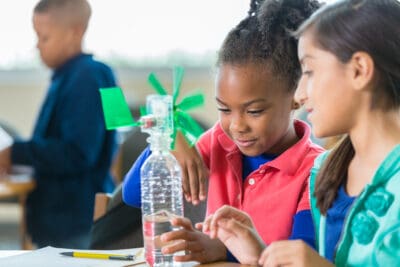
Possible Futures
JFF’s Possible Futures prepares learners in grades 6 through 10 for the future. Access and exposure to productive, family-supporting work play a critical role in our lives. However, as the labor market changes, fewer educators…

March 23, 2023
This Women’s History Month, let’s make history by giving women the opportunities they deserve in STEM fields. It’s no surprise that significant gender gaps persist: women make up less than 30% of the nation’s workforce in STEM, but those jobs are among the fastest-growing and highest-paying careers in today’s economy.
How do we level the playing field? Helping students develop a “STEM identity” increases the likelihood they will pursue a career in a STEM-related field. Strengthening STEM in K-12 education is, of course, essential, but reaching youth when they are not in school is also crucial. Leveraging this out-of-school time (OST)—which includes after-school, summer, youth development, and informal STEM learning spaces—is a proven and effective way to develop hands-on and career-connected learning that promotes STEM career pathways. It allows students to explore and be innovative, with flexibility often unavailable in the classroom.
In 2022, OST and STEM garnered well-earned recognition through the Bipartisan Safer Communities Act, boosting funding for the 21st Century Learning Centers Program, and the National Partnership for Student Success (NPSS) and the Engage Every Student Initiative (EEE), two unparalleled calls to action by the U.S. Department of Education (ED) to direct American Rescue Plan (ARP) funds towards universal access to high quality after-school and summer learning. In addition, through campaigns such as the Million Girls Moonshot and #GirlsLeadSTEM, the OST STEM field is working with urgency and intention to close gender gaps. But there’s more work to do! Read Jobs for the Future’s associate vice president Kyle Hartung’s recent op-ed, co-authored with Melissa Moritz, director of policy at the STEM Next Opportunity Fund, to learn more about what can be achieved if we invest in OST as a core strategy for closing stubborn STEM education and workforce gaps.
Now is the time to ensure that unprecedented support for OST outlives the ARP funds of this current administration and time-bound initiatives such as NPSS and EEE. Beyond sustainable and stable funding, another key strategy continues to be public-private partnerships such as those happening in states where SEAs are partnering with after-school networks to ensure ARP funds go to the programs best positioned to reach students most in need of support and opportunities beyond the school day. In addition, the development of state and regional STEM ecosystems that include a broad array of STEM and workforce stakeholders is a promising approach to sharing and aligning resources and expertise among leaders from education, business and industry, non-profits, philanthropy, and others. Progress is being made to intentionally support the expansion of high-quality STEM in Out-of-School time as a highly impactful way to effectively engage all students—and particularly girls (cis, non-binary, gender expansive) of all backgrounds!

JFF’s Possible Futures prepares learners in grades 6 through 10 for the future. Access and exposure to productive, family-supporting work play a critical role in our lives. However, as the labor market changes, fewer educators…

Our national movement transforms how U.S. education and workforce systems prepare young people for meaningful careers. With over a decade of leadership in the pathways movement, we bring incomparable expertise, collaboration, and a relentless curiosity…